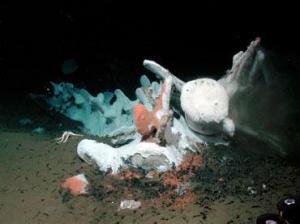Osedax worms have been found in Australian waters for the first time. Osedax worms are ‘whale’ worms, worms that feed on the bones of dead whales. They were recently found burrowed deep inside the bones of a pilot whale hauled up from a deep-sea abyss off Byron Bay, New South Wales (no pun intended).
The skull and spine of the pilot whale were both hauled up from the abyss off Australia’s east coast. Scientists discovered Osedax worms burrowed deep inside the bones and sucking on the marrow.
The worms are only 1-cm long. They have previously been found in parts of the Pacific and Atlantic oceans. Scientists believe that the worms have been around for millions of years and that they once fed on aquatic dinosaur bones.
A report in the Sunday Mail newspaper on 18th June 2017 described the Osedax worms as blood-red, faceless ‘zombie worms’ “with a craving for bones instead of brains”.
The Marine Biodiversity Hub posted some video footage on Facebook at https://www.facebook.com/marinebiodiversityhub/videos/1701518923485849/ (“Sampling the Abyss – Maggie Georgieva talks about whale-skull worms”). This was then ‘shared’ on our own Facebook page.
In the video footage, Maggie describes Osedax worms as polychaete worms. ‘Osedax’ is Latin for ‘bone eating’.
I have previously written two Newsletter articles (November 2005 http://seadragon.podzone.org/nletters/november2005.htm & January 2006 http://seadragon.podzone.org/nletters/january2006.htm ) and two Journal articles (2012 & 2013) regarding Osedax worms.
The two newsletter articles were parts 1 & 2 of my article titled “Greg Rouse’s Marine Worm (& Feather Star) Research”.
The first Journal article, “Osedax Worms” was published in our 2012 Journal. The second Journal article, “Osedax Worms Update” was published in our 2013 Journal.
Here are some of the photos from the 2012 Journal: –
These “bone-devouring worms,” known to both eat and inhabit dead whale skeletons
and other bones on the sea floor, have a unique ability to release bone-melting acid.
(Credit: Greg Rouse)
Two vertebrae with one that has not been attacked by Osedax (bottom)
and the other with a female Osedax on it. (Credit: Greg Rouse)
This photograph shows a female boneworm in the genus Osedax, which has been carefully removed from the whale bone in which it was growing. This worm has green, feathery palps, which extract oxygen from seawater. At its lower end are an ovisac and bulbous “roots,” which would normally be embedded in the whale bone. (Credit: Copyright 2009 Greg Rouse) Source: http://www.sciencedaily.com/releases/2009/11/091109194741.htm
This 30 million year old rib fragment of a whale shows the circular boreholes (diameter: 0,5 mm) made by Osedax. (Credit: Copyright Uni Kiel) Source: http://www.sciencedaily.com/releases/2010/04/100420101220.htm
When a whale dies, it sinks to the seafloor and becomes food for an entire ecosystem. Researchers have discovered previously unknown species that feed only on dead whales – and use DNA technology to show that the species diversity in our oceans may be higher than previously thought. (Credit: Craig R Smith) Source: http://www.sciencedaily.com/releases/2009/09/090921091601.htm
The tiny Osedax worms live inside the carcasses of dead whales – and eat their bones
(A computer-generated reconstruction of the Osedax worm responsible for borings found in a fossil whale bone in the Mediterranean, showing its root-like tissues used for feeding. Credit: Image courtesy of University of Leeds.)
A blog found at http://nanopatentsandinnovations.blogspot.com.au/2012/07/acid-wielding-worms-drill-through-bones.html features this photo of a piece of whalebone with worms being collected. (Photo: Monterey Bay Aquarium and Research Institute)









The R.V. Investigator, CSIRO’s research vessel, collected a whale skull during a 31-day voyage from Tasmania to the Coral Sea. The Investigator was mapping the seafloor, collecting specimens and trawling for rubbish the whole way. They found a number of Osedax worms on the whale skull. These worms are described as “mouthless fleshy tubes that hang around until bacteria has broken down the bone marrow and suck up the resulting soup” on the web page found at https://www.theguardian.com/environment/2017/jun/17/voyage-to-the-sea-floor-expedition-returns-with-fascinating-finds?CMP=soc_567. The RV Investigator was equipped with state-of-the-art sonar equipment, which captured a 12km wide swathe of the ocean floor, providing the first accurate picture of the seafloor off the Australian coastline.